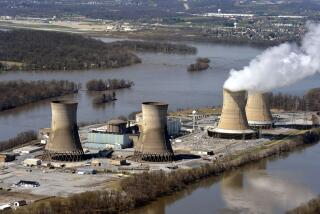Engineer’s Career Is Also Reactor’s
- Share via
He was a young engineer not long out of college and recently married. His new job: help build a nuclear reactor.
Thirty-five years later, Jarlath Curran is nearing retirement age. But he’s got one more thing to do: help tear down that reactor.
Curran, 61, is one of the reasons Southern California Edison Co. chose this as the year to begin decommissioning Unit I of the San Onofre Nuclear Generating Station. The company wanted some of the engineers who built it and ran it for years to help dismantle the 450-megawatt reactor, which provided energy for up to 500,000 homes and businesses from 1968 to 1992.
Curran isn’t exactly happy with the assignment. “I never envisioned decommissioning a nuclear reactor,” he said. “Because they can be maintained such that they could really operate indefinitely.”
Scientifically, this may be so; economically, it isn’t--the reactor would have needed more than $100 million in upgrades to continue operating.
“It’s disappointing,” the Mission Viejo resident said. “Any engineer associated with operating a reactor plant wants to see it continue to operate. But that’s the way it is.”
The massive job is expected to take eight years and $460 million, said plant spokesman Ray Golden. Utility officials say they expect no rate increase.
Workers have started preliminary work, moving furniture, checking radioactivity of building components and removing asbestos. They will begin taking apart the emergency diesel generator building this week.
The reactor, along with three steam generators and a pressurizer, will be taken out of the containment building from 2001 to 2003, and the building will be demolished from 2006 to 2008, Golden said.
The reactor vessel, which is contaminated and will weigh about 500 tons when filled with concrete grout as a safety measure, will be taken by slow-moving rail at night to Oceanside, where it will be loaded onto a barge. The barge will pass through the Panama Canal to reach a nuclear waste dump in Barnwell, S.C.--the only facility in the nation that will accept it.
Spent nuclear fuel, uranium, is now stored at the plant underwater in hundreds of metal assemblies. These 12-foot-tall assemblies, which will remain radioactive for tens of thousands of years, will be moved into steel-reinforced concrete vaults from 2004 to 2005.
These vaults will be stored at the plant because no repository for high-level radioactive waste yet exists, although the U.S. Department of Energy is required by law to remove the spent fuel and safely store it at such a facility for thousands of years.
The government has been studying a repository site that could open as early as 2010 at Yucca Mountain in Nevada. The Energy Department would then begin removing spent fuel from nuclear plants across the country and could remove assemblies from San Onofre Unit I by 2024.
Critics, such as the Sierra Club, doubt that the Yucca Mountain facility will be built by then and say leaving the spent uranium on site turns a stunning stretch of the coast into a nuclear waste dump.
But Golden counters that the law is clear: The government is obligated to find a permanent home for the used fuel. “It’s a matter of when, not if,” he said.
Plant officials say the storage method, known as dry casking, is safer than the current cooling pools because it requires no maintenance, which leaves room for human error or technical failure.
Critics’ fears of the stored fuel are needless and driven by a lack of understanding of nuclear power, Golden said. “The general population is scientifically challenged. Most people could not explain what electricity is or how it’s made.”
Fascination with nuclear power and a belief that it’s a superior energy source have kept Curran at San Onofre.
Curran’s jobs during his tenure at San Onofre, have included Unit I plant manager, from 1977 to 1981. For nuclear plants across the nation, that was a busy time. He recalls the construction of Units II and III, which at 1,120 megawatts apiece make San Onofre the second largest nuclear plant in the nation. He remembers the protests of the late 1970s, and the safety improvements after the partial meltdown at Three Mile Island in 1979.
Retirement age at the plant is generally 65, meaning Curran could retire in 2004. But Curran said he sees no reason to stop--even after the start of demolition for the reactor that brought him to San Onofre in 1965. “It’s a fun job, an interesting and challenging job,” he said.
(BEGIN TEXT OF INFOBOX / INFOGRAPHIC)
OUT OF COMMISSION
Workers recently began the eight-year tastk of decommissioning San Onofre’s Unit 1 reactor, the oldest of three nuclear generators at the plant. The $460-million project will remove and dispose of radioactive materials inside the containment dome and clean up lingering contamination on site.
More to Read
Sign up for Essential California
The most important California stories and recommendations in your inbox every morning.
You may occasionally receive promotional content from the Los Angeles Times.











